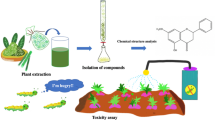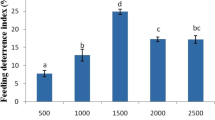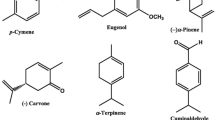Abstract
Screening the biological activities of plant secondary metabolites on economic pests can lead to discovery new ecofriendly biopesticides. The aim of this work was to evaluate the antifeedant, growth inhibitory and toxic activities of seven monoterpenes, two phenylpropenes and two sesquiterpenes on 2nd larval instar of Spodoptera littoralis. The tested compounds induced a significant antifeedant effect at various concentrations (500, 1000 and 2000 mg/kg), particularly after 6 and 9 days of exposure. Among the tested compounds, trans-cinnamaldehyde, α-terpinene, (−)-citronellal and 1,8-cineole were the most potent antifeedants after the three exposure periods. In general the tested compounds showed remarkable antifeedant activity after 9 days of exposure as their antifeedant indices ranged between 44.0 and 80.1%. On the other hand, the tested compounds drastically inhibited the growth of S. littoralis larvae at the tested concentrations. The larval growth inhibition ranged between 21.4 and 100% with cuminaldehyde, 1,8-cineole and eugenol being the most potent growth inhibitors. Some of the tested compounds caused significantly higher antifeedant and growth inhibitory effects than a reference insecticide, pyriproxifen. In general, the tested compounds showed higher growth inhibition than antifeedant effect. The tested compound also induced S. littoralis larval morality which improved with increasing exposure time and concentration. Cuminaldehyde, 1,8-cineole and (−)-carvone showed highest toxicity with 100.0, 97.0 and 77.0% mortality, respectively, at 2000 mg/kg after 9 days of exposure. Biochemical studies revealed that trans-cinnamaldehyde (IC50 = 0.03 mM), farnesol (IC50 = 0.04 mM) and eugenol (IC50 = 0.06 mM) are potent α-amylase inhibitors. These three compounds also caused significant inhibition of total proteases activity. This is the first report on antifeedant, growth inhibitory and insecticidal activities of the tested compounds on S. littoralis. Moreover, the strong bioactivity reported in this study indicated that these compounds have a potential to be used as bioinsecticides.

Similar content being viewed by others
References
Abbassy MA, Abdelgaleil SAM, Rabie RYA (2009) Insecticidal and synergistic effects of Majorana hortensis essential oil and some of its major constituents. Entomol Exp Appl 131:225–232
Abdelgaleil SAM (2010) Molluscicidal and insecticidal potential of monoterpenes on the white garden snail, Theba pisana (Muller) and the cotton leafworm, Spodoptera littoralis (Boisduval). Appl Entomol Zool 45:425–433
Abdelgaleil SAM, El-Aswad AF (2005) Antifeedant and growth inhibitory effects of tetranortriterpenoids isolated from three meliaceous species on the cotton leafworm, Spodoptera littoralis (Boisd.). Res J Appl Sci 1:234–241
Abdelgaleil SAM, El-Sabrout AM (2018) Anti-nutritional, antifeedant, growth-disrupting and insecticidal effects of four plant essential oils on Spodoptera littoralis (Lepidoptera: Noctuidae). J Crop Prot 7:135–150
Abdelgaleil SAM, Abbassy MA, Belal AH, Abdel-Rasoul MAA (2008) Bioactivity of two monoterpenoids isolated from Artemisia judaica L. Bioresouce Technol 99:5947–5950
Abdelgaleil SAM, Mohamed MIE, Badawy MEI, El-Arami SAA (2009) Fumigant and contact toxicities of monoterpenes to Sitophilus oryzae (L.) and Tribolium castaneum (Herbst) and their inhibitory effects on acetylcholinesterase activity. J Chem Ecol 35:518–525
Abou-Taleb HK (2016) Effects of azadirachtin and methoxyfenozide on some biological and biochemical parameters of cotton leafworm, Spodoptera littoralis (Lepidoptera: Noctuidae). Egypt Sci J Pestic 2:17–26
Ali AM, Mohamed DS, Shaurub EH, Elsayed AM (2017) Antifeedant activity and some biochemical effects of garlic and lemon essential oils on Spodoptera littoralis (Boisduval) (Lepidoptera: Noctuidae). J Entomol Zool Stud 5:1476–1482
Arasu MV, Al-Dhabi NA, Saritha V, Duraipandiyan V, Muthukumar C, Kim SJ (2013) Antifeedant, larvicidal and growth inhibitory bioactivities of novel polyketide metabolite isolated from Streptomyces sp. AP-123 against Helicoverpa armigera and Spodoptera litura. BMC Microbiol 13:105
Bakry N, Taman F, Zeid M (1973) Effect of nutrition, age and temperature on toxicity of insecticides to Spodoptera littoralis (Boisd). I Egypt Pest Cont Cong, Assiut, pp 105–115
Ballesta-Acosta MC, Pascual-Villalobos MJ, Rodriguez B (2008) The antifeedant activity of natural plant products towards the larva of Spodoptera littoralis. Span J Agric Res 6:85–91
Basak SS, Candan F (2010) Chemical composition and in vitro antioxidant and antidiabetic activities of Eucalyptus camaldulensis. Essent oil J Iran Chem Soc 7:216–226
Capinera JL (2008) Cotton Leafworm, Spodoptera littoralis (Boisduval). In: Capinera JL (ed) Encyclopedia of entomology. Springer, Dordrecht
Céspedes CL, Alarcón J, Aranda E, Becerra J, Silva M (2001) Insect growth regulator and insecticidal activity of ß-dihydroagarofurans from Maytenus spp. (Celastraceae). Z Naturforsch 56c:603–613
Cohort Software Inc (1985) Costat User’s Manual. Version 3. Tucson, AZ: Cohort
Czaja K, Góralczyk K, Struci’nski P, Hernik A, Korczn W, Minorczyk M, Lyczewska M, Ludwicki JK (2015) Biopesticides-towards increased consumer safety in the European Union. Pest Manag Sci 71:3–6
De Sales PM, De Souza PM, Simeoni LA, Magalhães PO, Silveira D (2012) α-Amylase inhibitors: a review of raw material and isolated compounds from plant source. J Pharm Pharmaceut Sci 15:141–183
Dudareva N, Pichersky E (2008) Metabolic engineering of plant volatiles. Curr Opin Biotechnol 19:181–189
El-Aswad AF, Abdelgaleil SAM, Nakatani M (2003) Feeding deterrent and growth inhibitory properties of limonoids from Khaya senegalensis (Desr.) against the cotton leafworm, Spodoptera littoralis (Boisd.). Pest Manag Sci 60:199–203
El-Defrawi ME, Tappozada A, Mansour N, Zeid M (1964) Toxicological studies on the Egyptian cotton leafworm Prodenia litura L.: susceptibility of different larval instars of Prodenia to insecticides. J Econ Entomol 57:591–593
Finney DJ (1971) Probit Analysis, 3rd edn. Cambridge University Press, London
Fischer NH, Williamson GB, Weidenhamer JD, Richardson DR (1994) In search of allelopathy in the Florida scrub: the role of terpenoids. J Chem Ecol 20:1355–1379
Gonzalez AG, Jimenez IA, Ravelo AG, Coll J, Gonzalez JA, Lloria J (1997) Antifeedant activity of sesquiterpene from celastraceae. Biochem Syst Ecol 25:513–519
Hernández-Carlos B, Gamboa-Angulo M (2019) Insecticidal and nematicidal contributions of Mexican flora in the search for safer biopesticides. Molecules 24:897–940
Kanda D, Kaur S, Koul O (2016) A comparative study of monoterpenoids and phenylpropanoids from essential oils against stored grain insects: acute toxins or feeding deterrents. J Pest Sci 90:531–545
Kaufman RA, Tietz NW (1980) Recent advances in measurements of amylase activity – a comparative study. Clin Chem 26:846–853
Kohl KD, Pitman BC, Robb JW, Connelly MD, Dearing FJS (2015) Monoterpenes as inhibitors of digestive enzymes and counter-adaptations in a specialist avian herbivore. J Comp Physiol B 185:425–434
Koul O, Shankar JS, Kapil RS (1996) The effect of neem allelochemicals on nutritional physiology of larval Spodoptera litura. Entomol Exp Appl 79:43–50
Langenheim JH (1994) Higher plant terpenoids: a phytocentric overview of their ecological roles. J Chem Ecol 20:1223–1280
Miresmailli S, Isman MB (2014) Botanical insecticides inspired by plant-herbivore chemical interactions. Trends Plant Sci 19:29–35
Mohen M, Gujar T (2003) Characterization and comparison of midgut proteases of Bacillus thuringiensis susceptible and resistant diamondback moth (Lepidoptera: Plutellidae). J Invertebr Pathol 82:1–11
Olga L, Ibrahim MM, Candas NC, Koller NC, Bauer LS, Bulla LA (2002) Changes in proteases activity and cry 3Aa toxin binding in the Colorado potato beetle: implications for insect resistance to Bacillus thuringiensis toxins. Insect Biochem Mol Biol 32:567–577
Ortego F, Lopez-Olguın J, Ruız M, Castanera P (1999) Effects of toxic and deterrent terpenoids on digestive protease and detoxication enzyme activities of Colorado potato beetle larvae. Pestic Biochem Physiol 63:76–84
Pavela R (2010) Antifeedant activity of plant extracts on Leptinotarsa decemlineata say. And Spodoptera littoralis bois. Larvae. Ind Crop Prod 32:213–219
Pavela R (2014) Acute, synergistic and antagonistic effects of some aromatic compounds on the Spodoptera littoralis Boisd. (Lep., Noctuidae) larvae. Ind Crop Prod 60:247–258
Pavela R (2016) History, presence and perspective of using plant extracts as commercial botanical insecticides and farm products for protection against insects – a review. Plant Prot Sci 52:229–241
Peixoto MG, Bacci L, Blank AF, Araújo APA, Alves PB, Silva JHS, Santos AA, Oliveira AP, da Costa AS, Arrigoni-Blank MF (2015) Toxicity and repellency of essential oils of Lippia alba chemotypes and their major monoterpenes against stored grain insects. Ind Crop Prod 71:31–36
Rajkumar V, Gunasekaran C, Christy IK, Dharmaraj J, Chinnaraj P, Paul CA (2019) Toxicity, antifeedant and biochemical efficacy of Mentha piperita L. essential oil and their major constituents against stored grain pest. Pestic Biochem Physiol 156:138–144
Rani AS, Murty US (2009) Antifeedant activity of Spilanthes acmella flower head extract against Spodoptera litura (Fabricius). J Entomol Res 33:55–57
Saad MG, Abou-Taleb HK, Abdelgaleil SAM (2018) Insecticidal activity of monoterpenes and phenylpropenes against Sitophilus oryzae L. and their acetylcholinesterase and adenosine triphosphatases inhibitory effects. Appl Entomol Zool 53:173–181
Sosa A, Costa M, Salvatore A, Bardon A, Borkosky S, Vera N (2017) Insecticidal effects of eudesmanes from Pluchea sagittalis (Asteraceae) on Spodoptera frugiperda and Ceratitis capitata. Int J Eenviron Agric Biotechnol 2:2456–1878
Srivastav RP, Prokscht P, Wray V (1990) Toxicity and antifeedant activity of a sesquiterpene lactone from Encelia against Spodoptera littoralis. Phytochemistry 29:3445–3344
Sudha P, Zinjarde SS, Bhargava SY, Kumar AR (2011) Potent α-amylase inhibitory activity of Indian Ayurvedic medicinal plants. BMC Complement Altern Med 11:5
Szczepanik M, Szumny A, Wawrzeńczyk C (2009) The effect of α-methylenelactone group on the feeding deterrent activity of natural and synthetic alkenes against Colorado potato beetle, Leptinotarsa decemlineata say. Pol J Environ Stud 18:1107–1112
Szczepanik M, Gliszczynska A, Hnatejko M, Zawitowska B (2016) Effects of halolactones with strong feeding-deterrent activity on the growth and development of larvae of the lesser mealworm, Alphitobius diaperinus (Coleoptera: Tenebrionidae). Appl Entomol Zool 51:393–401
Timmins WA, Reynolds SE (1992) Azadirachtin inhibits secretion of trypsin in midgut of Manduca sexta caterpillars, reduced growth due to impaired protein digestion. Entomol Exp Appl 63:47–54
Tonial F, Maia BHLNS, Savi DC, vicente VA, Gomes RR (2017) Biological activity of Diaporthe terebinthifolii extracts against Phyllosticta citricarpa. FEMS Microbiol Lett 364:1–7
Ukeh DA, Umoetok SBA (2011) Repellent effects of five monoterpenoid odours against Tribolium castaneum (Herbst) and Rhyzopertha dominica (F.) in Calabar, Nigeria. Crop Prot 30:1351–1355
Watanabe Y, Mihara R, Mitsunaga T, Yoshimura T (2005) Termite repellent sesquiterpenoids from Callitris glaucophylla heartwood. Forest Ecol Manag 258:1918–1923
Wu H, Wu H, Wang W, Liu T, Qia M, Feng J, Li X, Liu Y (2016) Insecticidal activity of sesquiterpene lactones and monoterpenoid from the fruits of Carpesium abrotanoides. Ind Crop Prod 92:77–83
Zahran HA, Abdelgaleil SAM (2011) Insecticidal and developmental inhibitory properties of monoterpenes on Culex pipiens L. (Diptera: Culicidae). J Asia Pac Entomol 14:46–51
Zapata N, Budia F, Vinuela E, Medina P (2009) Antifeedant and growth inhibitory effects of extracts and drimanes of Drimys winteri stem bark against Spodoptera littoralis (Lep., Noctuidae). Ind Crop Prod 30:119–125
Acknowledgments
This research was partially funded by the Alexandria University Research Fund (ALEX-REP).
Author information
Authors and Affiliations
Corresponding author
Ethics declarations
Conflict of Interest
The authors declare that they have no conflict of interest.
Additional information
Publisher’s note
Springer Nature remains neutral with regard to jurisdictional claims in published maps and institutional affiliations.
Rights and permissions
About this article
Cite this article
Abdelgaleil, S.A.M., Abou-Taleb, H.K., Al-Nagar, N.M.A. et al. Antifeedant, growth regulatory and biochemical effects of terpenes and phenylpropenes on Spodoptera littoralis Boisduval. Int J Trop Insect Sci 40, 423–433 (2020). https://doi.org/10.1007/s42690-019-00093-8
Received:
Accepted:
Published:
Issue Date:
DOI: https://doi.org/10.1007/s42690-019-00093-8




